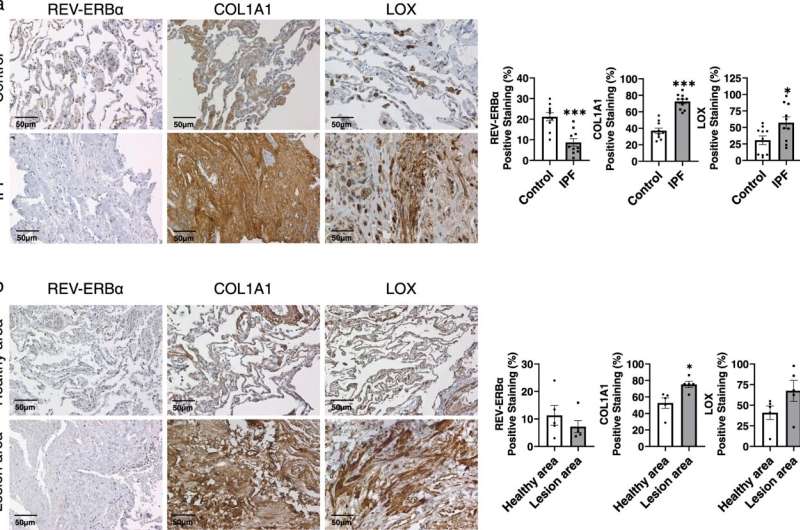This article has been reviewed according to Science X's editorial process and policies. Editors have highlighted the following attributes while ensuring the content's credibility:
fact-checked
peer-reviewed publication
trusted source
proofread
Study reveals mechanism by which a circadian clock molecule leads to lung fibrosis

Abnormal sleep patterns, like those of night-shift workers, disrupt the body's natural biological clock and have been linked to lung health issues. A new study by University of Rochester Medical Center (URMC) researchers shows how a biological clock molecule, called REV-ERBα, contributes to lung scarring, uncovering new potential drugs and drug targets along the way.
Pulmonary fibrosis, or lung scarring, is a serious condition in which connective tissue builds up in the lungs, making them thick and rigid, and causing difficulty breathing. While medications can ease the symptoms of pulmonary fibrosis, none can repair the lung damage caused by this sometimes-fatal disease.
The URMC study, published in Nature Communications, confirms a previously-discovered link between the body's biological clock (or circadian rhythm) and lung diseases and uncovers a new mechanism underlying this link. Study authors show that a lack of the circadian rhythm protein, REV-ERBα, contributes to lung scarring in mice by increasing production of collagen, a major component of connective tissue, and lysyl oxidase, which stabilizes connective tissue and makes it more rigid.
The team, which was led by Irfan Rahman, Ph.D., Dean's Professor of Environmental Medicine at URMC, found low levels of REV-ERBα and large amounts of collagen and lysyl oxidase in lung samples from patients with pulmonary fibrosis. Inducing lung injury in mice had a similar outcome: reduced REV-ERBα levels and increased levels of collagen, lysyl oxidase, and other markers of fibrosis.
As a circadian rhythm protein, REV-ERBα expression normally fluctuates throughout the day, peaking at noon and dipping to its lowest levels at midnight. When the team induced lung injury at night, mice had larger increases in lysyl oxidase and collagen proteins, more extensive lung damage, and lower survival rates compared to mice injured in the morning.
Rahman said this could be relevant to night-shift workers who are exposed to lung irritants at work. "Night-shift work usually occurs during the midnight timeframe when the expression of REV-ERBα is lowest," he said. "Our study suggests there is less protection against lung fibrosis generated from REV-ERBα activation at night."
When the team induced lung injury in genetically modified mice that express low levels of REV-ERBα, the mice had worse outcomes that appeared to be mediated by increased collagen and lysyl oxidase. After 15 days of infection with influenza A, these mice had greater upregulation of collagen and lysyl oxidase gene expression, worse flu infections, and worse lung injury compared with mice who expressed normal levels of REV-ERBα.
Activating REV-ERBα with a drug 14 days after lung injury in mice that express normal levels of REV-ERBα slightly reduced collagen and lysyl oxidase gene expression and improved lung health in the mice, though not significantly. When tested in cell cultures, the REV-ERBα-activating drugs had an anti-fibrotic effect.
"Currently, there are only two drugs approved by the FDA to treat fibrosis, and they only delay the process, they don't cure the disease," said study author Qixin Wang, Ph.D., a postdoctoral fellow working in Rahman's lab. "REV-ERBα-activating drugs could serve as potential therapeutics to help prevent fibrosis and stop the disease process."
But, he adds, a better REV-ERBα drug or a more direct way to deliver the drug is needed. In their studies, mice treated with the REV-ERBα-activating drug SR9009 lost more weight and had lower survival than untreated mice.
While further research is needed, Rahman and Wang believe their findings open new possibilities for developing treatments for all sorts of fibrotic diseases—especially those with a circadian component, like nighttime alcohol consumption causing liver fibrosis.
More information: Qixin Wang et al, Circadian clock molecule REV-ERBα regulates lung fibrotic progression through collagen stabilization, Nature Communications (2023). DOI: 10.1038/s41467-023-36896-0



















